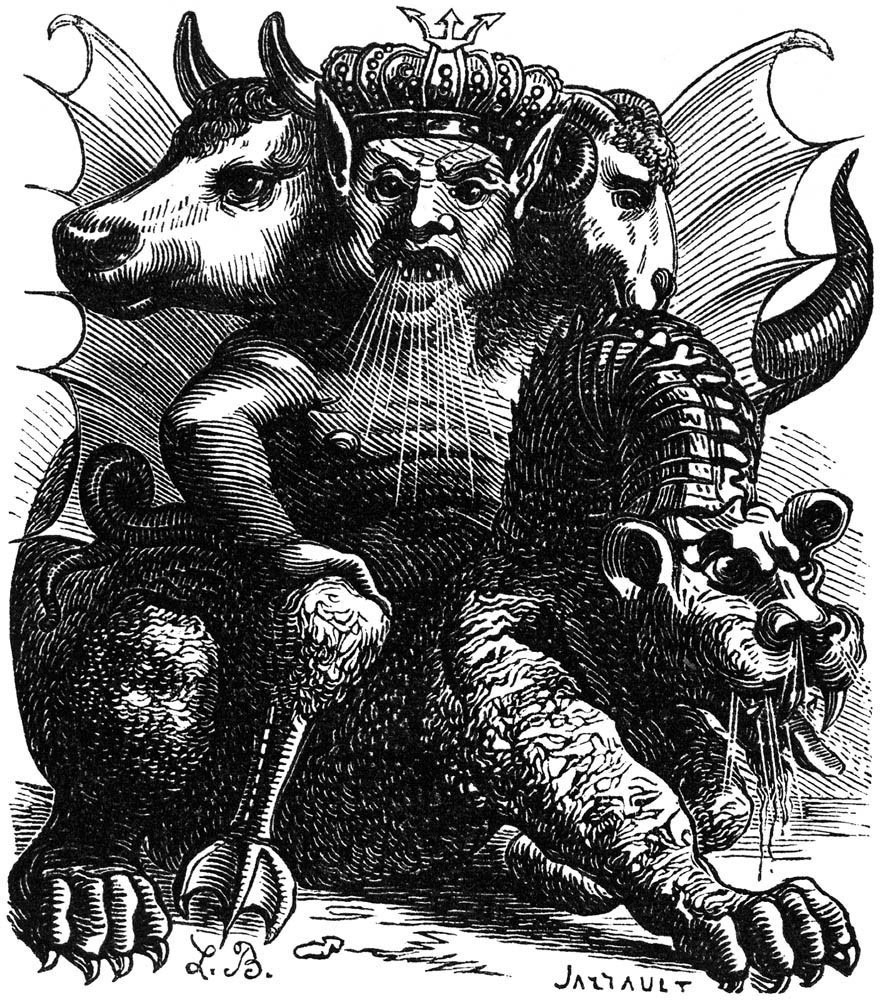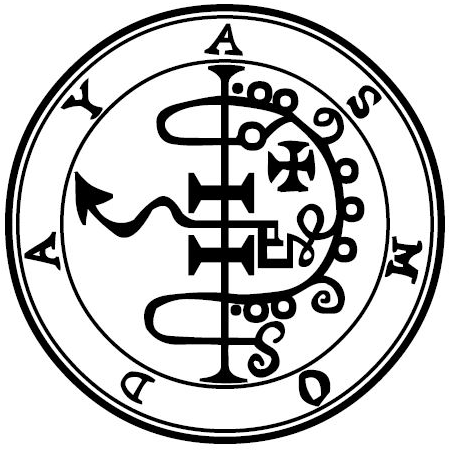Asmoday

Asmoday, also known as Asmodeus (/ˌæzməˈdiːəs/; Ancient Greek: Ἀσμοδαῖος, Asmodaios) or Ashmedai (/ˈæʃmɪˌdaɪ/; Hebrew: אַשְמְדּאָי, ʾAšmədʾāy), as well as Asmodevs, Ashema Deva or Amias (see below for other variations), is a prince of demons, or in Judeo-Islamic lore the king of the earthly spirits (shedim/jinn), mostly known from the deuterocanonical Book of Tobit, in which he is the primary antagonist.
Asmoday is the 32nd Goetic demon and rules over the Revengers of Evil in the hierarchy of Hell. He is ruled over by the Kabbalistic angel Vasariah and is a servant demon to those born August 22 - 26.
In the Black Mass ceremony used by notorious French poisoner La Voisin, Asmoday was called a "Prince of Friendship" along with Astaroth.
Name
The spellings Asmodai, Asmodee (also Asmodée), Osmodeus, and Osmodai have also been used. The name is alternatively spelled in the bastardized forms (based on the basic consonants אשמדאי, ʾŠMDʾY) Hashmedai (חַשְמְדּאָי, Hašmədʾāy; also Hashmodai, Hasmodai, Khashmodai, Khasmodai), Hammadai (חַמַּדּאָי, Hammadʾāy; also Khammadai), Shamdon (שַׁמְדּוֹן, Šamdōn), and Shidonai (שִׁדֹנאָי, Šidonʾāy). Some traditions have subsequently identified Shamdon as the father of Asmodeus.
The Jewish Encyclopedia of 1906 rejects the otherwise accepted etymological relation between the Persian "Æshma-dæva" and Judaism's "Ashmodai" claiming that the particle "-dæva" could not have become "-dai" and that Æshma-dæva as such—a compound name—never appears in Persian sacred texts. Still, the encyclopedia proposes that the "Asmodeus" from the Apocrypha and the Testament of Solomon are not only related somewhat to Aeshma but have similar behaviour, appearance and roles, to conclude in another article under the entry "Aeshma", in the paragraph "Influence of Persian Beliefs on Judaism", that Persian Zoroastrian beliefs could have heavily influenced Judaism's theology on the long term, bearing in mind that in some texts there are crucial conceptual differences while in others there seems to be a great deal of similarity, proposing a pattern of influence over folk beliefs that would extend further to the mythology itself.
However, the Jewish Encyclopedia asserts that although 'Æshma does not occur in the Avesta in conjunction with dæva, it is probable that a fuller form, such as Æshmo-dæus, has existed, since it is paralleled by the later Pahlavi-form "Khashm-dev"'. Furthermore it is stated that Asmodeus or Ashmedai "embodies an expression of the influence that the Persian religion or Persian popular beliefs have exercised" on Judaism.
In the Hebrew Bible
The full name "Ashmedai" is not found in the standard Masoretic canon of the Hebrew Bible.
In the Book of Tobit
The Asmodeus of the Book of Tobit is hostile to Sarah, Raguel's daughter, (Tobit 6:13); and slays seven successive husbands on their wedding nights, impeding the sexual consummation of the marriages. In the New Jerusalem Bible translation, he is described as "the worst of demons" (Tobit 3:8).
When the young Tobias is about to marry her, Asmodeus proposes the same fate for him, but Tobias is enabled, through the counsels of his attendant Archangel Raphael, to render him innocuous. By placing a fish's heart and gall on red-hot cinders, Tobias produces a smoky vapour that causes the demon to flee to Egypt, where Raphael binds him (Tobit 8:2–3). According to some translations, Asmodeus is strangled.
Perhaps Asmodeus punishes the suitors for their carnal desire, since Tobias prays to be free from such desire and is kept safe. Asmodeus is also described as an evil spirit in general: 'Ασμοδαίος τὸ πονηρὸν δαιμόνιον or τὸ δαιμόνιον πονηρόν, and πνεῦμα ἀκάθαρτον (Tobit 3:8; Tobit 3:17; Tobit 6:13; Tobit 8:3).
In the Talmud
The figure of Ashmedai in the Talmud is less malign in character than the Asmodeus of Tobit. In the former, he appears repeatedly in the light of a good-natured and humorous fellow. But besides that, there is one feature in which he parallels Asmodeus, in as much as his desires turn upon Bathsheba and later Solomon's wives.
Another Talmudic legend has King Solomon tricking Asmodai into collaborating in the construction of the Temple of Jerusalem.
Another legend depicts Asmodai throwing King Solomon over 400 leagues away from the capital by putting one wing on the ground and the other stretched skyward. He then changed places for some years with King Solomon. When King Solomon returned, Asmodai fled from his wrath. Similar legends can be found in Islamic folklore. There Asmodeus is called Sakhr (Arabic: صخر the Rock or the Stony One), because in Islamic lore, Solomon banished him into a rock, after he takes his kingdom back from him. There he counts as the king of the jinn.
Another passage describes him as marrying Lilith, who became his queen.
In the Testament of Solomon
In the Testament of Solomon, a 1st–3rd century text, the king invokes Asmodeus to aid in the construction of the Temple. The demon appears and predicts Solomon's kingdom will one day be divided (Testament of Solomon, verse 21–25). When Solomon interrogates Asmodeus further, the king learns that Asmodeus is thwarted by the angel Raphael, as well as by sheatfish found in the rivers of Assyria. He also admits to hating water and birds because both remind him of God. Asmodeus claims that he was born of a human mother and an angel father.
In the Malleus Maleficarum
In the Malleus Maleficarum, Asmodeus was considered the demon of lust. Sebastien Michaelis said that his adversary is St. John. Some demonologists of the 16th century assigned a month to a demon and considered November to be the month in which Asmodai's power was strongest. Other demonologists asserted that his zodiacal sign was Aquarius but only between the dates of January 30 and February 8.
He has 72 legions of demons under his command. He is one of the Kings of Hell under Lucifer the emperor. He incites gambling, and is the overseer of all the gambling houses in the court of Hell. Some Catholic theologians compared him with Abaddon. Yet other authors considered Asmodeus a prince of revenge.
In the Dictionnaire Infernal
In the Dictionnaire Infernal by Collin de Plancy, Asmodeus is depicted with the breast of a man, a cock leg, serpent tail, three heads (one of a man spitting fire, one of a sheep, and one of a bull), riding a lion with dragon wings and neck, all of these creatures being associated with either lascivity, lust or revenge. The Archbishop of Paris approved his portrait.
In the Lesser Key of Solomon
Asmodai appears as the king "Asmoday" in the Ars Goetia, where he is said to have a seal in gold and is listed as number thirty-two according to respective rank.
He "is strong, powerful and appears with three heads; the first is like a bull, the second like a man, and the third like a ram; the tail of a serpent, and from his mouth issue flames of fire." Also, he sits upon an infernal dragon, holds a lance with a banner and, amongst the Legions of Amaymon, Asmoday governs seventy-two legions of inferior spirits.
Later depictions
In Christian thought
Asmodeus was named as an angel of the Order of Thrones by Gregory the Great. Asmodeus was cited by the nuns of Loudun in the Loudun possessions of 1634.
Asmodeus' reputation as the personification of lust continued into later writings, as he was known as the "Prince of Lechery" in the 16th-century romance Friar Rush. The French Benedictine Augustin Calmet equated his name with a fine dress. The 16th-century Dutch demonologist Johann Weyer described him as the banker at the baccarat table in Hell, and overseer of earthly gambling houses.
In the Kabbalah
According to the Kabbalah and the school of Shlomo ibn Aderet, Asmodeus is a cambion born as the result of a union between Agrat bat Mahlat, a succubus, and King David.
On the Tree of Death, Asmoday rules over the qlippoth Golachab.
In Islamic culture
The story of Asmodeus and King Solomon has a reappearance in Islamic lore. Asmodeus is commonly named Sakhr (rock) probably a reference to his fate in common Islam-related belief, there, after Solomon defeated him, Asmodeus was imprisoned inside a box of rock, chained with iron, and thrown into the sea. In his work Annals of al-Tabari, the famous Persian Quran exegete (224–310 AH; 839–923 AD) Tabari, referred to Asmodeus in Surah 38:34. Accordingly, the puppet is actually Asmodeus who took on the shape of Solomon for forty days, before Solomon defeated him.
Sakhr (Asmodeus) is consulted by Buluqiya, a young Jewish prince, who tried to find the final prophet, Muhammad, in The Nights. During their conversation, he asked about hell, thereupon Asmodeus describes the different layers (ṭabaqāt) of hell.
| Goetic demons of the Lesser Key of Solomon | ||
|---|---|---|
| Previous Demon | This Demon | Next Demon |
| Foras | Asmoday | Gaap |
